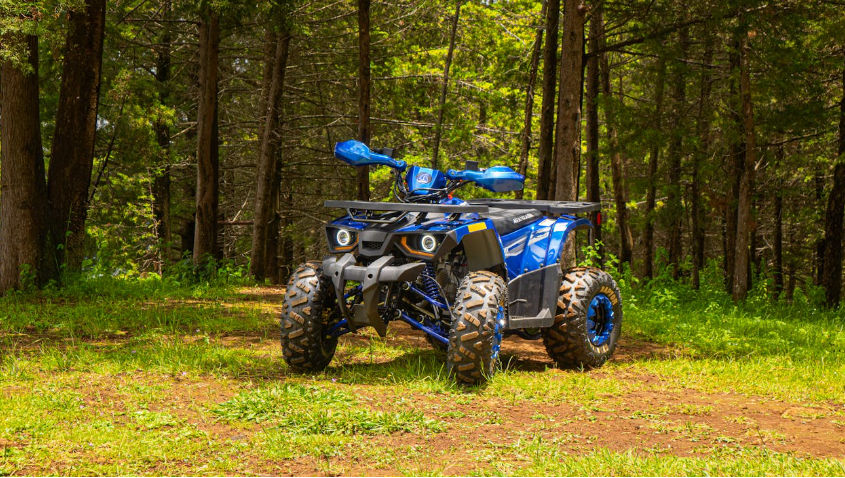At a Glance:
- Mud tyres have aggressive, wide-gap treads and tall, directional lugs for better mud traction.
- Mud tyres have reinforced sidewalls and higher ply ratings to prevent punctures. Sand and softer terrain tyres have lighter, more flexible construction.
- Mud tyres use softer rubber for better grip in slippery conditions, while hard terrain tyres use harder rubber for durability and wear resistance.
When you’re gearing up for an ATV adventure, the type of terrain you’re tackling is a critical factor in choosing the right tyres. Specifically, muddy terrains demand tyres that can handle slippery, unpredictable conditions. Let’s explore what sets ATV tyres for muddy terrain apart from those designed for other terrains. We will look at tread pattern, lug design, sidewall protection, and two additional aspects: rubber compound and ply rating.
Tread Pattern
The tread pattern is the most noticeable difference between ATV tyres designed for muddy terrain and those intended for other terrains. Mud-specific tyres have a more aggressive tread pattern with deep, wide gaps between the lugs. This design allows the tyres to dig into the soft, slippery mud and maintain traction rather than getting clogged up.
In contrast, tyres designed for hard-packed or rocky terrains have a tighter tread pattern. This helps provide a smooth ride and maximises contact with the ground, which is essential for stability and control on solid surfaces.
Lug Design
Lug design plays a crucial role in how tyres perform in different conditions. For muddy terrains, the lugs on ATV tyres are typically taller and more pronounced. They often feature a directional pattern, which aids in propulsion through thick mud. The lugs’ sharp edges cut into the mud, helping the tyre to grip and push the ATV forward.
For other terrains like sand, the lugs are paddle-shaped, allowing the tyres to float and move through loose sand efficiently. On rocky or hard-packed surfaces, the lugs are smaller and more closely spaced, providing better grip and reducing the risk of punctures from sharp objects.
Sidewall Protection
Muddy terrains can hide various obstacles, such as rocks and tree roots. Therefore, ATV tyres designed for muddy conditions often have reinforced sidewalls to prevent punctures and abrasions. This added protection ensures that the tyres can withstand the rough, unpredictable nature of muddy trails.
In contrast, tyres designed for less abrasive terrain may not have such heavy sidewall protection. They focus more on flexibility and comfort, as they don’t face the same level of hidden dangers as muddy trails.
Rubber Compound
The rubber compound used in ATV tyres varies depending on the intended terrain. Mud tyres are often made from a softer rubber compound. This enhances their grip in slippery conditions but also means they can wear out faster on hard surfaces. The soft rubber compound ensures that the tyres remain pliable and can adapt to the uneven, soft nature of muddy terrains.
A harder rubber compound is preferred for other terrains, especially hard-packed and rocky ones. This increases the tyres’ durability and provides better resistance to wear and tear. The hard compound is also less prone to damage from sharp rocks and harsh conditions, ensuring longevity.
Ply Rating
The ply rating indicates the tyre’s strength and durability. Mud-specific ATV tyres typically have a higher ply rating, meaning they are built with more layers of material. This is necessary to withstand the potential punctures and damage that can occur in muddy, unpredictable environments.
Tyres designed for softer terrains, like sand, often have a lower ply rating. Since the terrain is less likely to cause damage, they don’t need as much reinforcement, making the tyres lighter and enhancing performance in these conditions.
Choosing the right ATV tyres is essential for a safe and enjoyable off-road experience. Muddy terrains demand tyres with an aggressive tread pattern, pronounced lug design, robust sidewall protection, softer rubber compound, and higher ply rating. Each of these aspects ensures that the tyres can handle the unique challenges posed by muddy trails.
On the other hand, tyres designed for other terrains, like sand, rocky, or hard-packed surfaces, have different features tailored to those conditions. When you buy ATV tyres, especially if you’re considering ATV tyres in Australia, knowing these differences can help you make an informed choice. The right tyres will not only improve your ATV’s performance but also keep you safe on your adventures.




